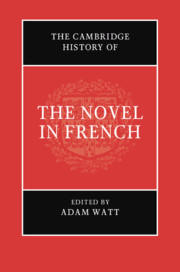58 results
VERTICO V: The environmentally driven evolution of the inner cold gas discs of Virgo cluster galaxies
-
- Journal:
- Publications of the Astronomical Society of Australia / Volume 40 / 2023
- Published online by Cambridge University Press:
- 27 April 2023, e017
-
- Article
-
- You have access
- Open access
- HTML
- Export citation
Copyright page
-
- Book:
- The Cambridge History of the Novel in French
- Published online:
- 04 February 2021
- Print publication:
- 25 February 2021, pp iv-iv
-
- Chapter
- Export citation
Figures
-
- Book:
- The Cambridge History of the Novel in French
- Published online:
- 04 February 2021
- Print publication:
- 25 February 2021, pp x-x
-
- Chapter
- Export citation
Part III - After the Revolution: The Novel in the Long Nineteenth Century
-
- Book:
- The Cambridge History of the Novel in French
- Published online:
- 04 February 2021
- Print publication:
- 25 February 2021, pp 255-400
-
- Chapter
- Export citation
Note on Conventions
-
- Book:
- The Cambridge History of the Novel in French
- Published online:
- 04 February 2021
- Print publication:
- 25 February 2021, pp xv-xv
-
- Chapter
- Export citation
Acknowledgements
-
- Book:
- The Cambridge History of the Novel in French
- Published online:
- 04 February 2021
- Print publication:
- 25 February 2021, pp xiv-xiv
-
- Chapter
- Export citation
25 - Marcel Proust’s À la recherche du temps perdu
- from Part IV - From Naturalism to the Nouveau Roman
-
-
- Book:
- The Cambridge History of the Novel in French
- Published online:
- 04 February 2021
- Print publication:
- 25 February 2021, pp 456-472
-
- Chapter
- Export citation
Part V - Fictions of the Fifth Republic: From de Gaulle to the Internet Age
-
- Book:
- The Cambridge History of the Novel in French
- Published online:
- 04 February 2021
- Print publication:
- 25 February 2021, pp 541-743
-
- Chapter
- Export citation
Contents
-
- Book:
- The Cambridge History of the Novel in French
- Published online:
- 04 February 2021
- Print publication:
- 25 February 2021, pp v-ix
-
- Chapter
- Export citation
Part IV - From Naturalism to the Nouveau Roman
-
- Book:
- The Cambridge History of the Novel in French
- Published online:
- 04 February 2021
- Print publication:
- 25 February 2021, pp 401-540
-
- Chapter
- Export citation
Part I - Beginnings: From the Late Medieval to Madame de Lafayette
-
- Book:
- The Cambridge History of the Novel in French
- Published online:
- 04 February 2021
- Print publication:
- 25 February 2021, pp 17-130
-
- Chapter
- Export citation
Chronology
-
- Book:
- The Cambridge History of the Novel in French
- Published online:
- 04 February 2021
- Print publication:
- 25 February 2021, pp xvi-xxii
-
- Chapter
- Export citation
Part II - The Eighteenth Century: Learning, Letters, Libertinage
-
- Book:
- The Cambridge History of the Novel in French
- Published online:
- 04 February 2021
- Print publication:
- 25 February 2021, pp 131-254
-
- Chapter
- Export citation
Introduction
-
-
- Book:
- The Cambridge History of the Novel in French
- Published online:
- 04 February 2021
- Print publication:
- 25 February 2021, pp 1-16
-
- Chapter
- Export citation
Index
-
- Book:
- The Cambridge History of the Novel in French
- Published online:
- 04 February 2021
- Print publication:
- 25 February 2021, pp 744-770
-
- Chapter
- Export citation
Contributors
-
- Book:
- The Cambridge History of the Novel in French
- Published online:
- 04 February 2021
- Print publication:
- 25 February 2021, pp xi-xiii
-
- Chapter
- Export citation

The Cambridge History of the Novel in French
-
- Published online:
- 04 February 2021
- Print publication:
- 25 February 2021
Chapter Four - From population to individual host scale and back again: testing theories of infection and defence in the Soay sheep of St Kilda
- from Part I - Understanding within-host processes
-
-
- Book:
- Wildlife Disease Ecology
- Published online:
- 28 October 2019
- Print publication:
- 14 November 2019, pp 91-128
-
- Chapter
- Export citation
Contributors
-
-
- Book:
- Essentials of Pediatric Anesthesiology
- Published online:
- 05 November 2014
- Print publication:
- 16 October 2014, pp ix-xii
-
- Chapter
- Export citation
Further reading
-
- Book:
- Marcel Proust in Context
- Published online:
- 05 November 2013
- Print publication:
- 05 December 2013, pp 241-255
-
- Chapter
- Export citation














